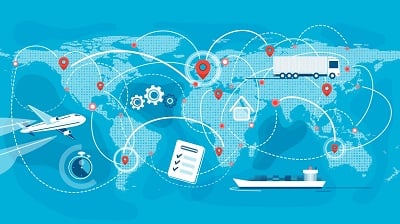Have you wondered how your business will respond to onshoring?
You see the onshoring trends. You felt the disruption of coronavirus. A critical supplier in your supply chain shut themselves down, and in effect shut you down with them. Or maybe you were the critical supplier that put your best customer in a tough position.
That is today’s reality, right?
But today’s reality is a catalyst for tomorrow’s change. Because of today’s reality decisions will be made with a different set of objectives. Instead of a focus on lowest cost and acceptable service, we will see risk play a bigger role.
Consider a decision-making formula used by most leaders the weighs cost + service/sales + risk.
Leaders will emphasize the latter part of the equation more now than they ever have in the past.
We are moving from an era of decisions based on lowest cost to a risk-averse era, where decisions consider risk. If you want to see how to weigh risk when you make decisions in your operation click this link for a webinar on Identifying Unknown Risks In Your Supply Chain.
A macro-level shift towards risk-aversion forces companies to respond. One of the responses that we expect to see at some degree in North America is onshoring/reshoring.
What Is Onshoring?
Onshoring is when a company outsources a supplier or service from inside their home country. Of course the opposite, offshoring, is when a company outsources a supplier from outside of their home country.
Why is onshoring a likely response to the global pandemic? Companies see onshoring as one of the ways they can minimize risk. By finding onshore suppliers they can lower, or at least spread out their risk across multiple suppliers.
Industry in North America will benefit from onshoring, but not without creating new business challenges.
So what are those new business challenges?
In this blog post, we’ll take a closer look at the business challenges created by onshoring in North America. But we’re also going to show what things looked like before, so you can see exactly the kind of changes that will have to happen.
Business Challenge #1: Supply Chains Will Be Redesigned
When a company makes the decision to include onshore suppliers it impacts the supply chain. Whether a company completely removes themselves from offshore (which is unlikely) or adds onshore suppliers to spread and minimize risk, they will need to redesign their supply chain.
They will have to ask difficult questions like:
- What should I outsource?
- What should I outsource onshore vs offshore?
- Where should I source it from?
- Who should I source it from?
- What’s my cost to serve?
- Where do I need a warehouse?
- What service level can I expect?
This creates a business challenge. How do you answer the questions quickly and execute ahead of your competition?
How To Do It:
Supply chain design is about structuring and managing the supply chain to meet your business objectives. So you should approach supply chain (re)design with this in mind. Look at the structure of your supply chain today, and consider alternative structures with your new suppliers.
At SimWell, we help companies with supply chain design or provide them with the tools to do it themselves.
One of the keys to success when you’re looking at the structure of your supply chain is being able to compare every scenario and communicate it to your team so everyone is in alignment.
We use a smart supply chain planning tool called anyLogistix that allows us to quickly create a digital copy of a supply chain and compare supply chain designs. What’s great about this tool is that once we optimize the design, we can use the tool for planning, sourcing, and risk-analysis.
If you are redesigning your supply chain, SimWell can help you analyze your options or provide the tools to do it yourself.
Business Challenge #2: Manufacturing Environments Will Be Stressed
As companies onshore, we will see a demand increase for US manufacturers. This will stress manufacturing environments and force companies to respond inside the four walls. Manufacturers will have to make decisions to meet increased demand. They will ask questions like:
- Can we meet demand with our existing production capabilities?
- Where should I make investments in the production line to meet demand?
- Should I buy equipment?
- Should I add a line?
- What equipment should I buy and how should I run it to meet throughput objectives?
This creates a business challenge. How do you increase throughput to meet demand?
How To Do It:
Work harder…buy a new machine…it’s that easy, right? One of the challenges with increasing throughput in a manufacturing environment is understanding where to make your investment to maximize ROI.
The way we approach this at SimWell is by taking a holistic approach to manufacturing products. We know that replacing a machine or adding a person might resolve a bottleneck in one place and create a bigger problem elsewhere. When that happens, you’re still missing your production goals and you’re not getting the most out of your investment.
We take a holistic approach to process improvement by replicating manufacturing in a virtual environment and testing improvement ideas.
When we capture the whole manufacturing line in a risk-free, virtual environment, we can test schedule changes, new equipment, new resources, and more to find out how each change will impact production.
We can then compare each alternative side by side to decide which is the right investment to meet our goals.
If you’re trying to decide on your manufacturing line and need help determining the right investments to make, SimWell can help you analyze your options.
Business Challenge #3: Finding The Optimal Way To Mix People, Automation, and Robotics
The demand increase in North American manufacturing will highlight the labor shortages in North America. This will also amplify the capacity and planning issues described in challenge 2, leading manufacturers to respond with automation and robotics.
Manufacturers will have to understand where they should/can rely on labor and where they should invest in automation and robotics, and how those assets can work together to meet demand.
They will ask questions like this:
- Where can I introduce automation and robotics into my facility?
- Where should I use labor?
- How much automation do I need?
- Where will I receive the highest ROI?
- How much labor do I need?
- How should I run the line with automation to meet objectives?
How To Do It:
Adding automation into an existing facility is not as simple as buying new equipment. You could buy a state-of-the-art machine and make your line run worse!
Why does that happen?
Production lines are created by a series of steps. If you introduce automation into one step without considering the others, your line may not be set up to run successfully with that new equipment. It is likely you’ll starve the machine or create a bottleneck further down the line.
When you introduce new equipment or new processes, you have to consider the production line as a system. This is especially true when you are introducing automation.
We have had countless projects in which manufacturers made major investments into automation and it did not have the results they were expecting, so they needed to invest more money to understand how automation should work together with the rest of the line to produce results.
At SimWell, we create a digital copy of facilities so that new ideas can be tested and proved before making an investment. When we build a digital copy of a plant or even a line, we can add automation into the digital version to see how the system will perform. We do this through simulation. When you have a simulation model, you can test changes at no-cost and in a risk-free environment so you are confident in the investments you make in the real world.
About Us
“For every complex problem there is an answer that is clear, simple, and wrong.” H.L. Mencken
At SimWell, we build simulation tools to help companies find the right answer to their problems. SimWell specializes in simulation, data science, and optimization.
If you need help answering a complex process with simulation, or you need to find the right tools to do it yourself we can help. It starts with a conversation.






